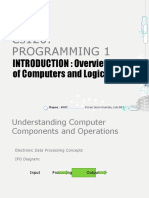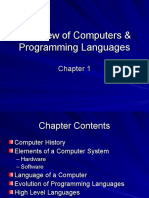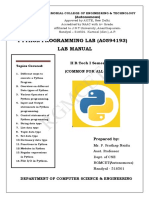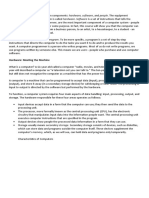Lecture 1: Computer Structure, Classification of Computer Programming Languages
Uploaded by
JuanDavinciLecture 1: Computer Structure, Classification of Computer Programming Languages
Uploaded by
JuanDavinciLecture 1: Computer Structure,
Classification of Computer
Programming Languages
Prof. Carolina Pea-Ortega
Universidad de la Salle
Outline
2
Computer Structure
Software: Operating System and Application
Software
Programming Languages
Program Development Life Cycle
Computer structure
3
What is a Computer?
4
A computer is an
electronic device that
manipulates information,
or data. It can store,
retrieve, and process
data.
Computer Hardware
5
The physical components of a computer.
Most computers have six basic components:
Main memory
The arithmetic/logic unit (ALU)
The control unit
Input/output devices
Auxiliary storage devices
Basic Components of a Computer
6
Arithmetic Logic Unit
Control Unit
Auxiliary
Storage
Device
Memory Unit ( RAM & Registers )
Central Processing Unit ( CPU )
Input Device
Output Device
Peripherals
Central Processing Unit (CPU)
7
The part of the computer that
executes the instructions
(program) stored in memory;
made up of the arithmetic/logic
unit and the control unit.
Central Processing Unit (CPU)
8
The arithmetic/logic unit (ALU) performs
arithmetic operations (addition, subtraction,
multiplication, and division) and logical
operations (comparing two values).
The control unit controls the actions of the other
components so that program instructions are
executed in the correct order.
Main Memory
9
Commonly known as random access memory
(RAM)
Holds instructions and data needed for programs
that are currently running
RAMis usually a volatile type of memory
Used as temporary storage
Secondary Storage
10
Anonvolatile storage medium
Hard disk drives are most common
Records data magnetically on a circular disk
Provides fast access to large amounts of data
Optical devices store data on CDs as pits
USB flash memory devices
High capacity device plugs into USB port
Portable, reliable, and fits easily in a pocket
Input/output (I/O) Devices
11
The parts of the computer that accept data to be
processed (input) and present the results of that
processing (output).
Input devices: any type of device that provides
data to a computer from the outside world.
Example: keyboard, mouse and scanner.
Output devices: any type of device that
provides data from a computer to the outside
world. Example: Monitor (display screen) and
printer.
Software
12
The programs that run on a computer
Two major categories:
Operating systems
Controls the processes within the computer
Manages the computer's hardware devices
Application Software
Solve problems or perform tasks needed by
users
Examples include word processing,
spreadsheets, games, Internet browsers,
playing music, etc)
Each program is referred to as an application
Concepts
13
Computer program: A sequence of instructions
to be performed by a computer.
Computer programming: The process of
planning a sequence of steps for a computer to
follow.
Algorithm: A step-by-step procedure for solving
a problemin a finite amount of time.
Programming language: A set of rules,
symbols, and special words used to construct a
computer program.
Classification of computer
programming languages
14
Programming Languages
15
The steps in our algorithm must be stated in a
formthe computer understands
The CPU processes instructions as a series of
1s and 0s called machine language
Machine language: The language, made up of
binary-coded instructions (strings of 0s and 1s),
that is used directly by the computer. It is no
portable, and it runs only on specific type of
computer.
Programming Languages
16
Assembly language: It is based on mnemonics
that symbolize processing steps (instructions),
processor registers, memory locations, and other
language features.
Use symbols instead of binary digits to describe
fields of instructions.
10101100100000100000000000010101
ADDI R4 R2 21
ADDI R4,R2,21
Assembler Program
17
A utility programcalled an assembler is used to
translate assembly language statements into the
target computer's machine code.
Source program: A programwritten in assembly
language.
Object program: The machine language version
of a source program.
Source
Program
(Assembly)
ASSEMBLER
Object
Program
Levels of Programming Languages
18
Low-Level Language: A computer language
that deals with hardware registers by name; also
known as assembly language.
A programwritten in a low-level language can be
used only on a computer system that uses one
type of main processor (or possibly a member of
a family of processors).
Low-level programming wastes effort in coding a
solution rather than solving a problem.
Difficult to build and maintain large programs.
Levels of Programming Languages
19
High-Level Language: High-level programming
languages allow the specification of a problem
solution in terms closer to those used by human
beings.
These languages were designed to make
programming far easier, less error-prone and to
remove the programmer fromhaving to knowthe
details of the internal structure of a particular
computer.
High-Level languages are portable, and they
require a compiler.
Compiler and Interpreter Languages
20
In addition to the distinction between high-level
and low-level languages, there is a further
distinction between compiler languages and
interpreter languages:
Compiler Languages: are the high-level
equivalent of assembly language. Each
instruction in the compiler language can
correspond to many machine instructions.
Compiler Languages
21
Once the program has been
written, it is translated to the
equivalent machine code by a
programcalled a compiler. Once
the programhas been compiled,
the resulting machine code is
saved separately, and can be
run on its own at any time.
Source
Program
COMPILER
Object
Program
Interpreter Languages
22
An interpreter language, like a
compiler language, is
considered to be high level.
However, it operates in a
totally different manner from a
compiler language. Rather, the
interpreter program resides in
memory, and directly executes
the high-level program without
preliminary translation to
machine code.
Source
Program
INTERPRETER
translation
and execution
line by line
Interpreter Languages
23
This use of an interpreter program to directly
execute the user's programhas both advantages
and disadvantages. The primary advantage is
that you can run the program to test its
operation, make a fewchanges, and run it again
directly.
In addition, because the interpreter has to scan
the user's program one line at a time and
execute internal portions of itself in response,
execution of an interpreted program is much
slower than for a compiled program.
Common Programming Languages
24
Visual Basic
Python
J avascript
J ava
C
C++
Code Examples
25
C
#include <stdio.h>
void main() {
printf("Hello, World!\n");
}
C++
#include <iostream>
void main(){
cout << "Hello, World!\n;
}
25
Machine Code
c7 3c 2a 3c 2a 2b 2a 5c 3c 28 5c 2a 2b 2a 5c 3c
28 5c 2a 2b 2a 5c 3c 28 5c 2a 2b 2a 5c 3c 28 5c
2a 2b 2a 5c 3c 28 5c 2a 2b 2a 5c 3c 28 5c 2a 2b
2a 5c 3c 28 5c 2a 2b 2a 5c 3c 28 5c 2a 2b 2a 5c
3c 28 5c 2a 2b 2a 5c 3c 28 5c 2a 2b 2a 5c 3c 28
Python
print "Hello, World!"
Program Development Life Cycle
26
Program Development Life Cycle
27
The basic set of procedures that are followed by
various organizations in their program
development methods are as follows:
1. Problem Definition
2. Algorithm Design
3. Coding
4. Debugging and Testing
5. Documentation
6. Maintenance
Program Development Life Cycle
28
Maintenance
Problem Definition
and Design
Documentation
Time
Stages of
Program
Development
Life Cycle
1
2
3
Phase 1: Problem Definition and Design
29
Problem
Definition
Coding
Time
Program Design
Debugging
and
Testing
Steps of
Problem
Definition
and Design
Phase 1: Problem Definition and Design
30
Step 1: Problem Definition
This stage is the formal definition of the task. It
includes the specification of inputs and outputs
processing requirements, system constraints,
and error handling methods.
This step is very critical for the completion of a
satisfactory program. It is impossible to solve a
problem by using a computer, without a clear
understanding and identification of the problem.
Inadequate identification of problem leads to
poor performance of the system.
Phase 1: Problem Definition and Design
31
This step is the process of becoming familiar with
the problem. This step includes the reviewing of
the design document that was prepared for the
program, as well as any systemwide information
that would be helpful.
The process ends when all the programmers
questions have been resolved and the
requirements of the programare understood.
Phase 1: Problem Definition and Design
32
Step 2: Algorithm Design
Once the problem has been identified, the next
stage is the program design. The programmer
must decide, prior to writing his program, exactly
which steps the computer should take to solve
an identified problem.
Such a functional description of the task is either
called an algorithmor results in a diagramcalled
flowchart.
Phase 1: Problem Definition and Design
33
The techniques that are useful in program design
include:
Modular Programming: A method in which long
programs are divided into smaller programs or
modulates that can be designed, coded and
debugged separately with a minimumamount of
interaction.
Main
Program
Module 1 Module 2
Module 11 Module 21 Module 22
Phase 1: Problem Definition and Design
34
Top-Down Design: A method in which the
overall task is first defined in terms of
generalized sub-tasks that, in turn, are
subsequently further defined. The process
continues downward until the sub-tasks are
defined in a formsuitable for execution by the
computer.
Phase 1: Problem Definition and Design
36
Step 3: Coding
The third step is the process of transforming the
programlogic design documents into a computer
language format.
This stage translates the program design into
computer instructions. These instructions are the
actual programor the software product.
During this step the programmer eliminates all
the syntax and formal errors from the program
and all logic errors are detected and resolved
during this process.
Phase 1: Problem Definition and Design
37
Step 4: Debugging and Testing
Debugging: This stage is the discovery and
correction of programming errors. Few
programs run correctly the first time, so
debugging is an important and time consuming
stage of software development.
Phase 1: Problem Definition and Design
38
Testing: This stage is the validation of the
program. Testing ensures that the program
performs correctly the required tasks. Program
testing and program debugging are closely
related. Testing is essentially a later stage of
debugging in which the programis validated by
trying it on a suitable set of cases.
Testing may reveal errors, but does not
guarantee the absence of errors.
Phase 1: Problem Definition and Design
39
Programming theorists often refer to program
debugging and testing as verification and
validation, respectively. Verification ensures that
the programdoes what the programmer intends
to do. Validation ensures that the programgives
the correct results for a set of test data.
Phase 2: Documentation
40
This stage is the documentation of the program so
that those who use and maintain it, can understand
it, so that the program can be extended to further
applications. Yet proper documentation is not only
useful in the testing and debugging stages, it is also
essential in the maintenance and redesign stages.
A properly documented program can be easily
reused when needed; an undocumented program
usually requires so much extra work that the
programmer might as well start fromscratch.
Phase 2: Documentation
41
Among the techniques commonly used in
documentation are flowcharts, comments,
memory maps, parameter and definition lists,
and programlibrary forms.
Documentation is a time consuming task that the
programmer performs simultaneously with the
design, coding, debugging and testing stages of
software development.
Phase 3: Maintenance
42
This stage is the updating and correcting of the
program to account for changing conditions or
field experience.
In order to reduce the costs and the time spent
on maintenance, we can use the following steps:
Clarity and readability of code.
Structured code.
Modularity.
Debugging and testing.
Documentation.
References
43
Programming in C++, Nell Dale and Chip Weems.
Chapter 1.
C++ for Engineers and Scientists, Gary J .
Bronson. Chapter 1.
You might also like
- Lecture Note 1. Introduction To Computer and ProgrammingNo ratings yetLecture Note 1. Introduction To Computer and Programming45 pages
- Topic 1 - Introduction To Computers and Programming PDFNo ratings yetTopic 1 - Introduction To Computers and Programming PDF37 pages
- Liang, Introduction To Java Programming, Eighth Edition, (C) 2011 Pearson Education, IncNo ratings yetLiang, Introduction To Java Programming, Eighth Edition, (C) 2011 Pearson Education, Inc43 pages
- Introduction To Components of A Computer SystemNo ratings yetIntroduction To Components of A Computer System32 pages
- Intro - To - Programming - PPT Filename UTF-8''intro To ProgrammingNo ratings yetIntro - To - Programming - PPT Filename UTF-8''intro To Programming33 pages
- Fundamentals of C++ Programming: Hochiminh University of Technology Computer Science and Engineering - (CO1011)No ratings yetFundamentals of C++ Programming: Hochiminh University of Technology Computer Science and Engineering - (CO1011)34 pages
- Cse Programming For Problem Solving Course ResourcesNo ratings yetCse Programming For Problem Solving Course Resources416 pages
- Chapter-1-Introduction Programming and Problem Solving ConceptsNo ratings yetChapter-1-Introduction Programming and Problem Solving Concepts35 pages
- Chapter 1-Introduction Programming-CS126-3rd QTR 2012 2013No ratings yetChapter 1-Introduction Programming-CS126-3rd QTR 2012 201396 pages
- Introduction To Computer Programming ConceptsNo ratings yetIntroduction To Computer Programming Concepts22 pages
- CSE 021 - Lec03 - Programming Basics - 09.11.21No ratings yetCSE 021 - Lec03 - Programming Basics - 09.11.2148 pages
- Introduction To Computer and ProgrammingNo ratings yetIntroduction To Computer and Programming45 pages
- JK C - 1 - An Overview of Programming LanguagesNo ratings yetJK C - 1 - An Overview of Programming Languages27 pages
- Introduction To Computer Systems, Programming Languages and ProgrammingNo ratings yetIntroduction To Computer Systems, Programming Languages and Programming41 pages
- 1 - Introduction to Computers and C++ ProgrammingNo ratings yet1 - Introduction to Computers and C++ Programming33 pages
- ICS 2102-Lecture 2 Programming ConceptsNo ratings yetICS 2102-Lecture 2 Programming Concepts49 pages
- Chapter 1 Introduction to Computer and Programming[1]No ratings yetChapter 1 Introduction to Computer and Programming[1]46 pages
- Introduction To C++ Computer ProgrammingNo ratings yetIntroduction To C++ Computer Programming10 pages
- (Ebook) X86 Assembly Language and C Fundamentals by Joseph Cavanagh ISBN 9781466568259, 1466568259 - Download the ebook today and own the complete content100% (1)(Ebook) X86 Assembly Language and C Fundamentals by Joseph Cavanagh ISBN 9781466568259, 1466568259 - Download the ebook today and own the complete content54 pages
- Rajiv Gandhi University of Knowledge Technologies: Python Programming LanguageNo ratings yetRajiv Gandhi University of Knowledge Technologies: Python Programming Language99 pages
- Module 1 - Introduction to Python and Computer ProgrammingNo ratings yetModule 1 - Introduction to Python and Computer Programming11 pages
- Programming Languages Vocabulary and DefinitionsNo ratings yetProgramming Languages Vocabulary and Definitions9 pages
- B.Sc. (Ag.) IVth Sem (Agri Informatics) by Mr. Sushant SrivastavaNo ratings yetB.Sc. (Ag.) IVth Sem (Agri Informatics) by Mr. Sushant Srivastava32 pages
- Ss3 Computer Note (Week One) Introduction to Hll_031746No ratings yetSs3 Computer Note (Week One) Introduction to Hll_0317467 pages
























































































